So put your Paws down and Come to Class!
MOVIN ON UP K9 Training
You'll work together with your Instructor to build a lifetime bond with your dog through fun and positive classes!
You'll work together with your Instructor to build a lifetime bond with your dog through fun and positive classes!
Nancy Creal/Auburn California
(Owner and Director of Instructors)
(530.457.7086)

(Owner and Director of Instructors)
(530.457.7086)

Rally Signs
- Designated wording and symbols for Rally Signs
- EXERCISES THAT MAY BE USED IN NOVICE, ADVANCED AND EXCELLENT CLASSES
- Exercises with an asterisk "*" (5, 6, 7, 8, 9, 10, 17, 18, 19, 34) may be used multiple times on a Rally course
| 1. START – Indicates the beginning of the course. |
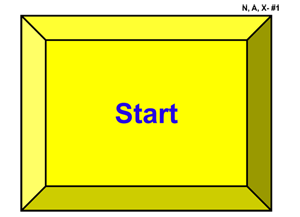
|
| 2. FINISH – Indicates the end of the course - timing stops. |
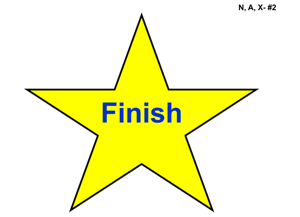
|
| 3. HALT – Sit. While heeling, the handler halts and the dog comes to a sit in heel position. The team then moves forward toward the next exercise sign (station), with the dog in heel position. (Stationary exercise) |
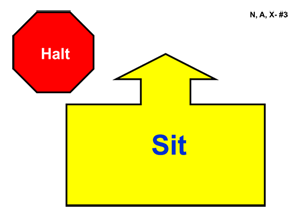
|
| 4. HALT – Sit – Down. While heeling, the handler halts and the dog comes to a sit. The handler then commands the dog to down, followed by the command to heel forward from the down position. (Stationary exercise) |
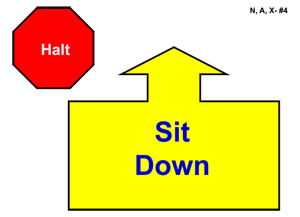
|
| 5. * Right Turn. Performed as a 90° turn to the right, as in traditional obedience. |
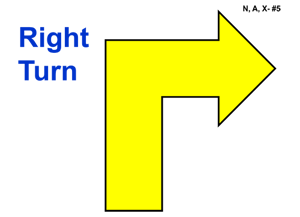
|
| 6. * Left Turn. Performed as a 90° turn to the left, as in traditional obedience. |
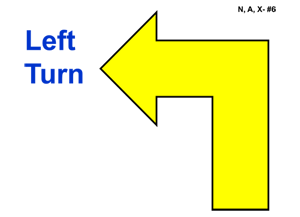
|
| 7. *About Turn – Right. While heeling, the team makes a 180° about turn to the handler's right. |
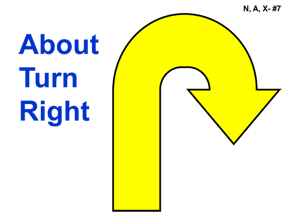
|
| 8. * About "U" Turn. While heeling, the team makes a 180° about turn to the handler's left. |
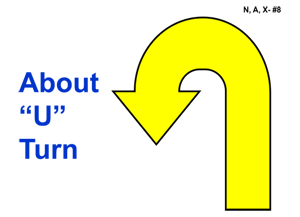
|
| 9. * 270° Right Turn. While heeling, the team makes a 270° turn to the handler's right. 270° turns are performed as a tight circle, but not around the exercise sign. |
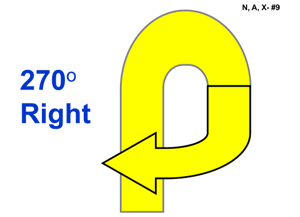
|
| 10. * 270° Left Turn. While heeling, the team makes a 270° turn to the handler's left. 270° turns are performed as a tight circle, but not around the exercise sign. |
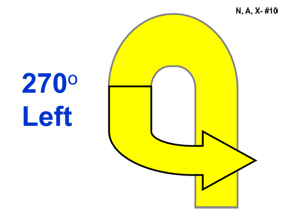
|
| 11. 360° Right Turn. While heeling, the team makes a 360° turn to the handler's right. 360° turns are performed as a tight circle, but not around the exercise sign. |
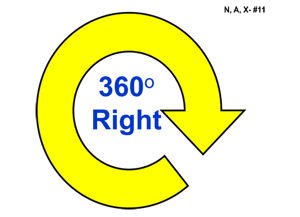
|
| 12. 360° Left Turn. While heeling, the team makes a 360° turn to the handler's left. 360° turns are performed as a tight circle, but not around the exercise sign. |
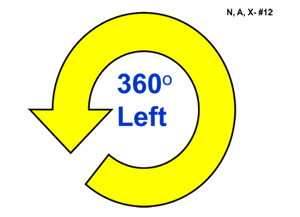
|
| 13. Call Front – Finish Right - Forward. While heeling, the handler stops forward motion and calls the dog to the front position (dog sits in front and faces the handler). The handler may take several steps backward as the dog turns and moves to sit in the front position. The second part of the exercise directs the handler to move forward while commanding the dog to change from the front position to the handler's right, around behind the handler and to heel position, as the handler continues forward. The dog does not sit before moving forward in heel position with the handler. (Stationary exercise) |
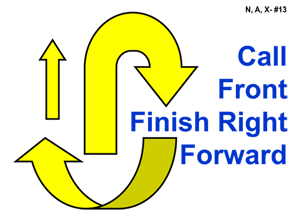
|
| 14. Call Front – Finish Left - Forward. While heeling, the handler stops forward motion and calls the dog to the front position (dog sits in front and faces the handler). The handler may take several steps backward as the dog turns and moves to sit in the front position. The second part of the exercise directs the handler to move forward while commanding the dog to change from the front position to the handler's left and moving to heel position, as the handler continues forward. The dog does not sit before moving forward in heel position with the handler. (Stationary exercise) |
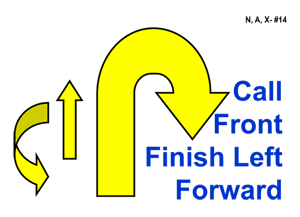
|
| 15. Call Front – Finish Right - HALT. While heeling, the handler stops forward motion and calls the dog to the front position (dog sits in front and faces the handler). The handler may take several steps backward as the dog turns and moves to sit in the front position. The second part is the finish to the right, where the dog must return to heel position by moving around the right side of the handler. Dog must sit in heel position before moving forward with the handler. (Stationary exercise) |
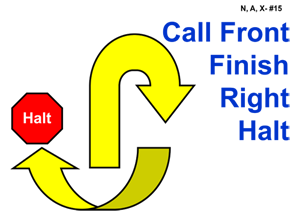
|
| 16. Call Front – Finish Left - HALT. While heeling, the handler stops forward motion and calls the dog to the front position (dog sits in front and faces the handler). The handler may take several steps backward as the dog turns and moves to a sit in the front position. The second part is the finish to the left, where the dog must move to the handler's left and sit in heel position. Dog must sit in heel position before moving forward in heel position with the handler. (Stationary exercise) |
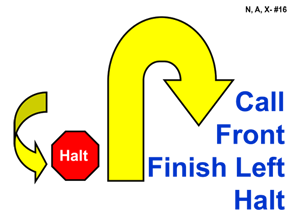
|
| 17. * Slow Pace. Dog and handler must slow down noticeably. This must be followed by a normal pace, unless it is the last station in the class. |
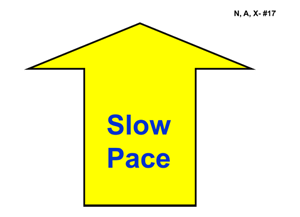
|
| 18. * Fast Pace. Dog and handler must speed up noticeably. This must be followed by a normal pace, unless it is the last station in the class. |
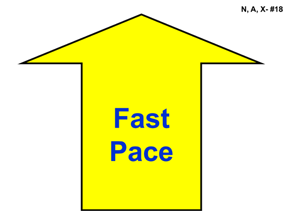
|
| 19. * Normal Pace. Dog and handler must move forward, walking briskly and naturally. |
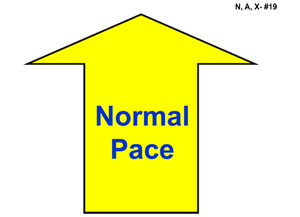
|
| 20. Moving Side Step Right. While heeling, the handler takes one step diagonally to the right and continues moving forward along the newly established line. The dog maintains heel position. The exercise may be performed just past the exercise sign. |
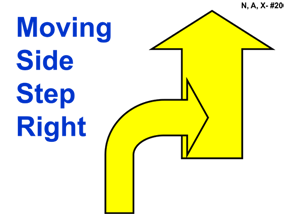
|
21. Spiral Right – Dog Outside. This exercise requires three pylons or posts placed in a straight line with spaces between them of approximately 6 - 8 feet. Spiral Right indicates the handler must turn to the right when moving around each pylon or post. This places the dog on the outside of the turns (See 1A and 1B). The exercise sign is placed near or on the first pylon or post where the spiral is started.
 |
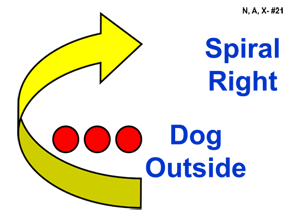
|
22. Spiral Left – Dog Inside. This exercise requires three pylons or posts placed in a dog on the inside of the turns (See 2). The exercise sign is placed near or on the first pylon or post where the spiral is started.
 |
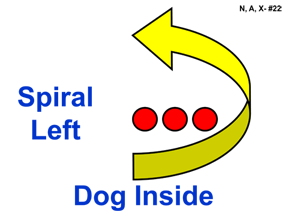
|
| 23. Straight Figure 8 Weave Twice. This exercise requires four obstacles (pylons, posts or people) placed in a straight line with spaces between them of approximately 6 - 8 feet. The exercise sign is placed near or on the first obstacle where the exercise is started. Entry into the weaving pattern is with the first obstacle at the dog/handler's left side. |
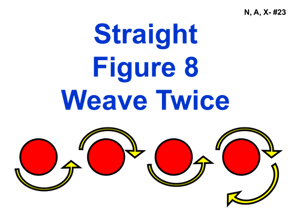
|
| 24. Serpentine Weave Once. This exercise requires four obstacles (pylons, posts or people) placed in a straight line with spaces between them of approximately 6 - 8 feet. The exercise sign is placed near or on the first obstacle where the exercise is started. Entry into the weaving pattern is with the first obstacle at the dog/handler's left side. It should be noted that in this exercise, the team does not weave back through the obstacles as they do in the Straight Figure 8. |
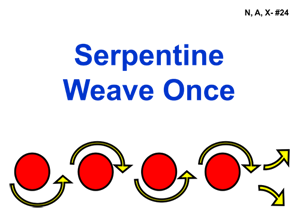
|
| 25. HALT – 1, 2, 3 Steps Forward. The team halts with the dog sitting in heel position to begin the exercise. The handler takes one step forward, with the dog maintaining heel position, and halts. The dog sits when the handler halts. This is followed by two steps forward - halt, and three steps forward - halt, with the dog heeling each time the handler moves forward, and sitting each time the handler halts. (Stationary exercise) |
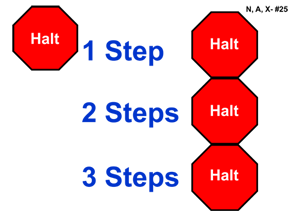
|
| 30. HALT – Walk Around Dog. With the dog sitting in heel position, the handler commands the dog to stay, then proceeds to walk around the dog to the left, returning to heel position. The handler must pause in heel position before moving forward to the next station. (Stationary exercise) |
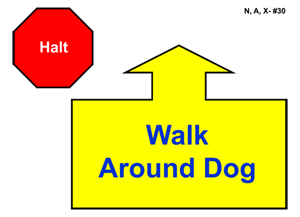
|
| 31. HALT – Down – Walk Around Dog. With dog sitting in heel position, the handler commands the dog to down and stay, then proceeds to walk around the dog to the left, returning to heel position. The handler must pause in heel position before moving forward to the next station.The dog heels forward from the down position. (Stationary exercise) |
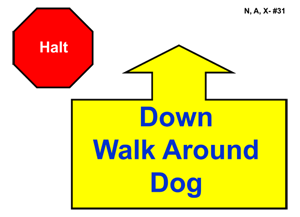
|
|
EXERCISES THAT MAY BE USED IN ADVANCED AND EXCELLENT CLASSES ONLY |
32. HALT – About Turn Right – Forward. With the dog sitting in heel position, the team turns 180° to the right and immediately moves forward. (Stationary exercise) |
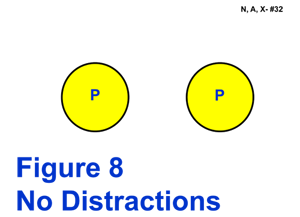
|
| 33. HALT – About "U" Turn – Forward. With the dog sitting in heel position, the team turns 180° to the left and immediately moves forward. (Stationary exercise) |
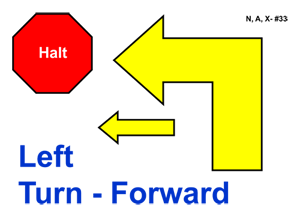
|
| 34. * Send Over Jump – Handler Runs By. While moving with the dog in heel position, the handler directs the dog to take the jump, as the handler runs by the jump. When the dog has completed the jump, it is called to heel position and the team continues to the next exercise. |
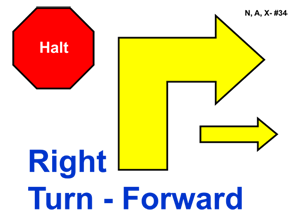
|
| 35. HALT – Turn Right One Step – Call to Heel - HALT. With the dog sitting in the heel position, the handler commands the dog to wait or stay. The handler then turns to the right, while taking one step in that direction, and halts. The dog is called to sit in heel position in the new location before moving forward to the next station. (Stationary exercise) |
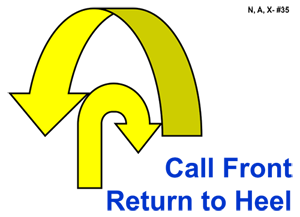
|
| 36. HALT – Stand – Walk Around Dog. With the dog sitting in heel position, the handler will stand the dog, command the dog to stay and walk around the dog to the left, returning to heel position. The handler must pause in heel position before moving forward to the next station. In the Advanced Class, the handler may touch the dog, move forward to stand the dog, and may pose the dog as in the show ring. (Stationary exercise) |
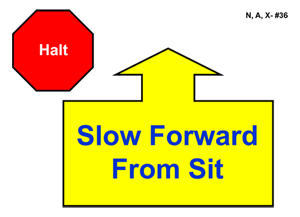
|
| 37. HALT - 90° Pivot Right – HALT. With the dog sitting in heel position, the team pivots 90° to the right, halts, the dog sits and then moves forward. (Stationary exercise) |
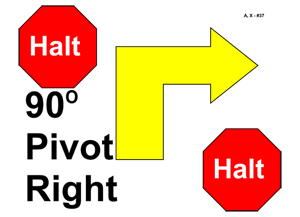
|
| 38. HALT - 90° Pivot Left – HALT. With the dog sitting in heel position, the team pivots 90° to the left, halts, the dog sits and then moves forward. (Stationary exercise) |
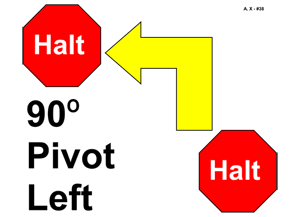
|
39. Offset Figure 8. This exercise requires two pylons, posts or people placed about 8 – 10 feet apart, around which the team will perform a complete Figure 8. Two distractions will be arranged to the sides of the Figure 8 about 5 – 6 feet apart. Entry may be between the pylons, posts or people and the distraction on either side (See 3A and 3B). The distractions will consist of two loosely covered, but secure, containers with tempting dog treats; however, dog toys may replace one or both containers, or may be placed next to the containers. The exercise sign may be placed on or near the cone where entry is made into the Offset Figure 8.
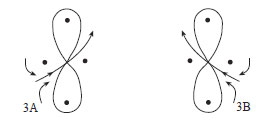 |
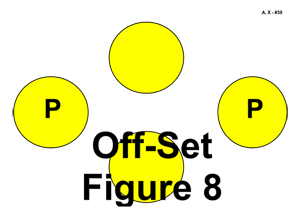
|
| 40. HALT – Side Step Right – HALT. With the dog sitting in heel position, the team moves one step directly to the right and halts. The dog moves with the handler and sits in heel position when the handler halts. The exercise may be performed just past the exercise sign. (Stationary exercise) |
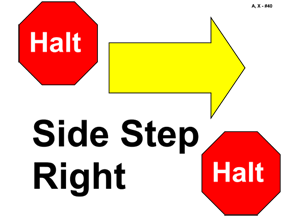
|
| 41. HALT – Call Dog Front – Finish Right. With the dog sitting in heel position, the handler calls the dog to front and the dog sits in the front position facing the handler. On command, the dog then moves from the front position around the right of the handler and sits in heel position. Handler may not step forward or backward to aid dog during exercise. (Stationary exercise) |
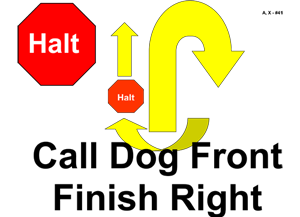
|
| 42. HALT – Call Dog Front – Finish Left. With the dog sitting in heel position, the handler calls the dog to front and the dog sits in the front position facing the handler. On command, the dog then moves from the front position to the handler's left and sits in heel position. Handler may not step forward or backward to aid dog during exercise. (Stationary exercise) |
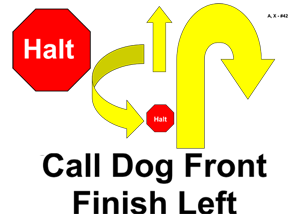
|
| 43. HALT – 180° Pivot Right – HALT. With the dog sitting in heel position, the handler pivots 180° to the right. The dog moves with the handler and sits in heel position. (Stationary exercise) |
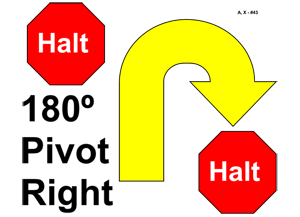
|
| 44. HALT - 180° Pivot Left – HALT. With the dog sitting in heel position, the handler pivots 180° to the left. The dog moves with the handler and sits in heel position. (Stationary exercise) |
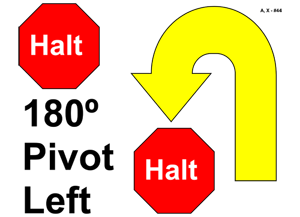
|
| 45. HALT – Down – Sit. With dog sitting in heel position, the handler commands the dog to down, then to sit. (Stationary exercise) |
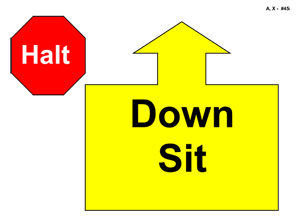
|
|
EXERCISES THAT MAY BE USED IN THE EXCELLENT CLASS ONLY |
|
| 46. HALT – Stand – Down. With dog sitting in heel position, the handler will stand the dog (without physical handling), then commands the dog to down. The handler then commands the dog to heel forward from the down position. (Stationary exercise) |
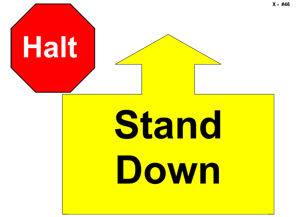
|
| 47. HALT – Stand – Sit. With dog sitting in heel position, the handler will stand the dog (without physical handling), then commands the dog to sit. (Stationary exercise) |
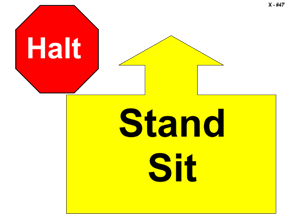
|
| 48. Moving Stand – Walk Around Dog. While heeling and with no hesitation, the handler will stand the dog, leave and walk around the dog to the left, returning to heel position. The handler must pause in heel position before moving forward to the next station. (Stationary exercise) |
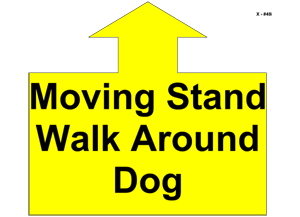
|
| 49. Back Up 3 Steps – Dog Stays in Position. While heeling, the handler reverses direction walking backward 3 steps, without first halting, then continues heeling forward. The dog moves backward with the handler and maintains position throughout the exercise without sitting. |
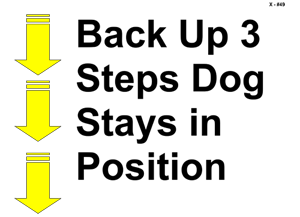
|
| 50. Honor. This exercise will be performed on leash. Dog and handler will enter through the exit gate, or may proceed directly to the Honor Station after completing the Excellent Course. The judge will designate whether the dog is to perform a sit-stay or a down-stay, which shall be for the duration of time it takes for the next dog to run the entire course. The judge will, also, designate whether the handler will stand next to the dog or stand facing the dog during the Honor exercise. All dogs in the class will perform the exercise in the same manner. The Honor dog will be monitored and scored by a steward, as directed by the judge. |
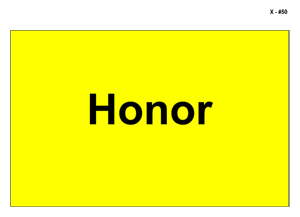
|
|
* May be used multiple times on a course. |
|
Home | About | Programs | Puppy | Therapy Dog Certification | C.L.A.S.S. | Calendar| Classes & Registration | Contact | Video Ad
